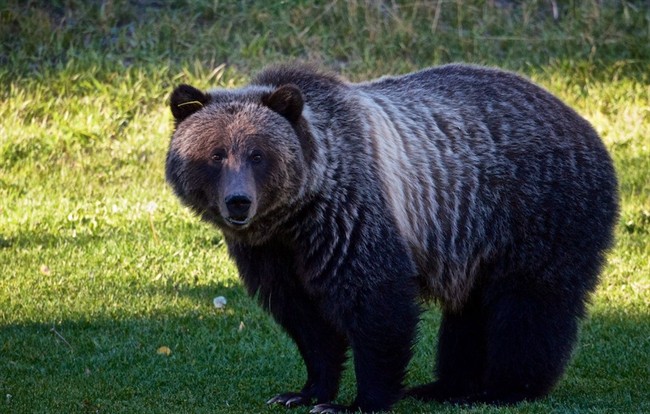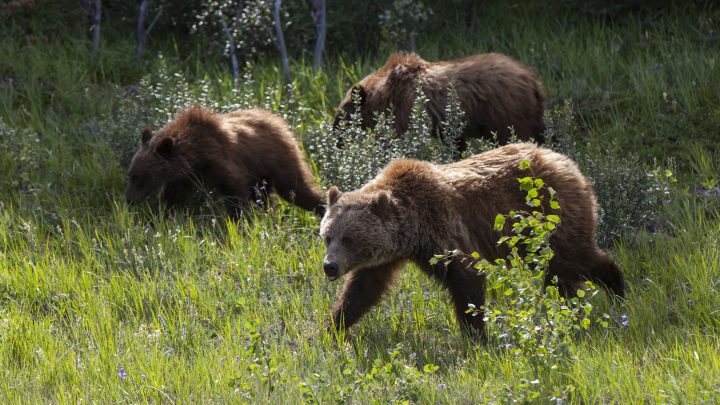The impact of climate change will have alarming consequences for grizzlies in the Rockies, according to new research from the University of Calgary’s geography department.

By 2080, buffaloberries in the Rocky Mountains will ripen three weeks earlier than they do now, which will widen the gap between when grizzlies have a berry banquet — a key food resource — and when they head off to hibernate.
“This development will change the behaviour of the grizzly bears, who are very food-focused,” said researcher Dr. Greg McDermid in a news release on Monday.
“We can expect to see them at times and in places where we’re not used to seeing them. I think it could be argued that we’re already witnessing that.”
A decade in the making, “Advances in phenology are conserved across scale in present and future climates” was published Monday in the journal Nature Climate Change.
Methodology
Researchers said this was a breakthrough in phenology: the timing of recurring events in nature, like hibernation, migration, flowers blooming in spring and leaves yellowing in autumn.
The breakthrough? Dr. David Laskin, McDermid’s former PhD student and lead author of the study, developed an accurate way of tracking phenology — when berries would ripen in Alberta — in the forest understory by using satellites to monitor ecosystem processes and climate forecasting to predict what will be in store by the century’s end.
The development of plants is tightly linked physiologically to temperature, Laskin said, making them good indicators of climate change.
“By using this methodology, we can keep track of the heat accumulation in the understory and then link that to the rate of development of buffaloberries,” Laskin said.
This way, scientists can predict when plants will hit certain parts of their life cycles now and in the future.
“One of the challenges is there’s a lot of species interaction going on in the forest understory and the satellite can only see the top of the canopy, so we used thermal sensors on the satellites to act as a window that could see in the understory beneath the canopy,” Laskin said.
Laskin likened this methodology a “litmus test,” a way to quantify rates of development and how it changes under different temperatures.

Get daily National news
This approach can be applied to many plants and species over broad areas, he said.
WATCH: This progression from U of C researchers tracks Canada buffaloberry through a single growing season from April 30, 2011 to Oct. 7, 2011.
‘Nose to the ground’
Grizzlies follow a schedule, eating different foods at different times of the year. Because bears in the Rockies are landlocked — meaning the animals can’t access salmon like they do on the coast — they eat a lot of plants.
“Grizzlies have their nose to the ground and they’re just moving from one resource to the next throughout the summer,” Laskin said. “What we found is by the end of the century, red berries are going to ripen about three weeks earlier than they do now. Without salmon, the berry crop is kind of a critical food event for bears here in the Rockies every year.
“Now that’s it’s moved further in the season, they have a longer time to go before hibernating and that might compromise their ability to reproduce because they may not be able to get enough fat on over that time. And the time that the berries are available will also be abbreviated.”

Impacts
There are two impacts that arise when berries develop earlier, Laskin said.
- Bears expect their key nutritional resource at a certain time of year, and if it’s not there, they have to make do before hibernation.
“They’ll have a longer stretch to go, so they are going to go into areas where we don’t normally see them at times that we don’t normally expect them,” Laskin said.
- Grizzly reproduction is linked to body condition.
“When they go down for hibernation, females need about 20 per cent body fat or greater for them to be able to carry young through the winter and successfully give birth,” Laskin explained. “If they don’t have that body fat percentage, they just simply won’t give birth.”
Why we should care
The timing that plants bloom has an impact on us, Laskin said. We don’t fully understand the interconnectedness of ecosystem processes.
“If there’s no pollinators when the flowers come out, that can have an impact on our crops, our food supply,” Laskin said. “That’s a direct impact on humans, not just natural systems, which we ultimately rely on as well.”
Key takeaway
The study demonstrates that everything in the ecosystem is connected.
“The impacts of climate change are going to be more subtle than we think,” Laskin said.
“It’s going to affect linkages that I think we’re unaware of, but they will have impacts far greater than we can anticipate.”





Comments